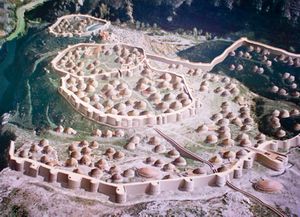قائمة دول العصر النحاسي
The Chalcolithic (English: /ˌkælkəlˈlɪθɪk/;[1] باليونانية: χαλκός khalkós، "copper" and λίθος líthos، "stone")[1] period or Copper Age,[1] also known as the Eneolithic[1] or Æneolithic (from Latin aeneus "of bronze")، is a phase of the Bronze Age before it was discovered that adding tin to copper formed the harder bronze. The Copper Age was originally defined as a transition between the Neolithic and the Bronze Age. However، because it is characterized by the use of metals، the Copper Age is considered a part of the Bronze Age rather than the Stone Age.
تطور الدول
The development of states—large-scale، populous، politically centralized، and socially stratified polities/societies governed by powerful rulers—marks one of the major milestones in the evolution of human societies. Archaeologists often distinguish between primary (or pristine) states and secondary states. Primary states evolved independently through largely internal developmental processes rather than through the influence of any other pre-existing state. The earliest known primary states appeared in Mesopotamia ح. 3700 ق.م.، in Egypt c. 3300 ق.م.، في وادي السند c. 2500 ق.م.، India c 1700 ق.م.، and in China c. 1600 ق.م.. As they interacted with their less developed neighbors through trade، warfare، migration، and more generalized ideological influences، the primary states directly or indirectly fostered the emergence of secondary states in surrounding areas، for example، the Hittites in Anatolia، the Minoan and Mycenaean states of the Aegean، or the Nubian kingdoms in the Sudan. Professor Gil Stein at the University of Chicago Oriental Institute states The excavations and archaeological surveys of the last few decades have vastly increased both the quantity and quality of what we know about ancient states and urbanism. Archaeologists have broadened the scope of their research beyond the traditional focus on rulers and urban elites. Current research now aims at understanding the role of urban commoners، craft specialists، and village-based farmers in the overall organization of ancient states and societies. Given the immense geographical scope encompassed by the term “the Ancient World.[2]
هذه قائمة دول تواجدت من 5000 ق.م. حتى 3300 ق.م..
الدول
| الدولة | السنوات |
|---|---|
| آشور | 3500-1800 ق.م. |
| باد-تيبيرا | 5000-2300 ق.م. |
| إريدو | 5400-600 ق.م. |
| إسين | 3500-2100 ق.م. |
| أريحا - القديمة | 9000-1573 ق.م. |
| كيش | 4000-2300 ق.م. |
| لگش | 4000-2250 ق.م. |
| مصر السفلى - قبل الأسرات | 9000-3200 ق.م. |
| ماري | 5000-1759 ق.م. |
| گيرسو | 5000-2100 ق.م. |
| نيپور | 5000-2450 ق.م. |
| ثقافة سريدني ستوگ | 4500-3500 ق.م. |
| سوسا | 4200-2330 ق.م. |
| مصر العليا - قبل الأسرات | 4500-3200 ق.م. |
| أور | 4000-2000 ق.م. |
| أوروك | 4000-3100 ق.م. |
انظر أيضاً
- قائمة دول العصر البرونزي
- قائمة دول العصر الحديدي
- قائمة دول العصر الكلاسيكي
- قائمة الدول أثناء القدم المتأخر
- قائمة الدول أثناء العصور الوسطى
الهامش
- ^ أ ب ت ث The New Oxford Dictionary of English (1998) ISBN 0-19-861263-X، p. 301: "Chalcolithic /,kælkəl'lɪθɪk/ adjective Archaeology of، relating to، or denoting a period in the 4th and 3rd millennium ق.م.E، chiefly in the Near East and SE Europe، during which some weapons and tools were made of copper. This period was still largely Neolithic in character. Also called Eneolithic... Also called Copper Age - Origin early 20th cent.: from Greek khalkos 'copper' + lithos 'stone' + -ic".
- ^ Stein, Gil J (2001). Understanding Ancient State Societies in the Old World. New York: Kluwer Academic/Plenum Press. pp. 353–379.
